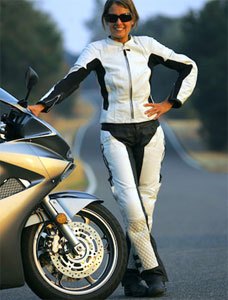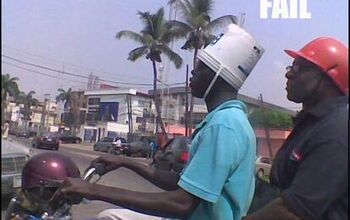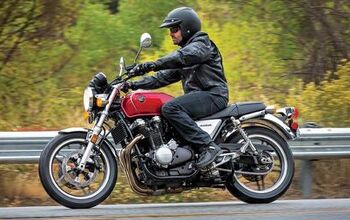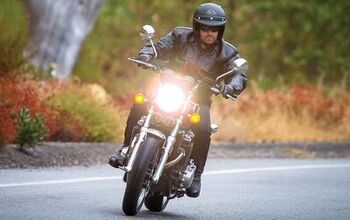What to Wear When You Ride - and Why
Just because you are free to ride your motorcycle or scooter in the U.S. with hardly enough clothing for a beach party does not mean it’s a good idea. And just because riders in at least 30 states may legally ride without helmets, also does not make this recommended.
Gear comes styled for every kind of riding, at several price points, and designed more comfortably than ever. Aside from its obvious intent of protecting you in a crash, proper clothing and a helmet can actually reduce fatigue and improve your focus.
And whether you think it’s too hot out, or gear costs too much, or you just don’t feel like it – none of these are excuses not to protect yourself. How would those who care about you like it if you were hurt or killed? You owe it to them, and you owe it to yourself.
While some want to debate the merits of helmets and gear, when push comes to shove, riders know. Or ask any racer. He or she understands a crash could happen any time and what are they required to wear?
| Allstate Insurance On Rider Safety |
Our friends at Allstate Motorcycle Insurance know a thing or two about motorcycle safety. In addition to Motorcycle.com's safety series, Allstate Motorcycle Insurance has its own valuable safety information to share. * Motorcycle Awareness: Safety Tips from Allstate Motorcycle Insurance |
Helmet
A helmet (and optional ear plugs) protects you from hearing loss, or being pelted by debris, insects, rain, hail, and it could one day save your life.
The National Highway Traffic Safety Administration (NHTSA) estimates helmets improve your odds by 37 percent. That is, for every 100 riders killed not wearing one, 37 riders could have lived had they all been wearing helmets.
There are several standards – U.S. Department of Transportation (DOT), Snell, and some European standards. While the Snell Foundation says its standard is superior, this is open to debate.
Based on several studies, we recommend at least the federally mandated DOT standard. Identified by a label on the back of the helmet, the DOT standard means the manufacturer says it will pass specific tests for impact protection, penetration, staying on your head, and more.
There are “half helmets,” partial coverage, and full face. A full face provides the most protection.
Jacket and pants
Well-designed rider clothing keeps you protected from windburn, sunburn, exhaust burns, and is a comfortable first line of defense.
Some riders wear a motorcycle jacket, but complete the outfit with street pants. Fact is, your legs are very vulnerable so why not protect them just as well?
In a crash, cotton dungarees tear through in less than one second. Shorts, khakis or sweat pants offer negligible safety value. Fashion leather may shred as instantly as cloth. If you choose leather, make sure it’s suitable for motorcycle use.
According to Dana Grindle, owner of Bates Custom Leathers in Signal Hill, Calif., while certain textiles can do a good job, especially when combined with built-in armor, high-tensile cowhide still offers the most abrasion resistance and tear-through strength.
For the heat of summer, manufacturers offer perforated leather or abrasion-resistant mesh. There are also several brands of textile jeans, if you absolutely don’t want the fully kitted look.
Whatever you wear, make sure it’s protective, said Rae Tyson, an experienced rider and NHTSA spokesman.
“Some of the worst crashes I’ve seen have been with people who fell off the motorcycle who were wearing short sleeves, or shorts, or a tank top, etc., and it’s not a pretty sight,” Tyson said, “Last time I checked your body was never designed for that.”
And Grindle concurred, adding motorcycle clothing can cost significant money, but if you crash once, you will not question whether it was worth it.
“Do you know what 20 mph does to your skin,” Grindle asked, “Oh my God, it can take it to the bone.”
This may sound dramatic, but she’s not kidding.
The skin covering your joints – knuckles, elbows, hips, knees, ankles, and shoulders – is especially easy to damage, and a crash can remove it, and even flesh, and healing can take a year or longer.
Built-in armor, or strapped-on armor under your clothing at these points is highly recommended!
Some gear comes with European-standard armor, rated “CE” level I (good), or level 2 (best).
Motorcycle clothing sold in the U.S. is not required to meet any certification, however. So be wary, but understand some premium American manufacturers have crash tested their armor and found it as good as or better than otherwise certified armor.
Boots and gloves
The hands and feet are intricate mechanisms made of many delicate bones. They can be crushed or broken far too easily. Boots should be heavy-duty leather with hard armor around the ankle, and ideally padding too. Leather gloves with long gauntlets should likewise have impact protection on the knuckles and palms, and even wrists.
Good advice
Spend enough time researching and talk to your dealer and others about your options. There are many great choices available and you should never gamble with your safety.
They say that sooner or later everyone crashes. If true, what would you want to be wearing if it became your turn?
Related Reading
How Well Do You Know Your Motorcycle?
Rider Education, Injuries and Fatalities
The SEE System: Increasing Your Visibility
Choose a Motorcycle That Fits
Motorcycle Insurance Basics
The American Culture of Motorcycle Safety
Group Riding 101
Should You Ride a Motorcycle
How to Load Your Motorcycle
Night Riding
Riding With a Passenger
Riding in the Rain and Wind
The Truth about Drinking and Riding
Road Conditions Quiz
Knowing How to Brake Saves (the most) Lives
More by Jeff Cobb






























Comments
Join the conversation